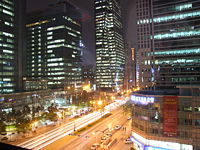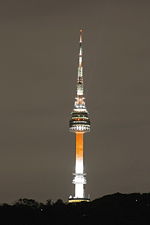|
|
|
|
|
|
|
|
|
|
|
|
Seoul (2)South Korea - Asia

Yeouido Island, Seoul, at dawn. As a Special City, it is administered directly by the national government. With over ten million people, Seoul is South Korea's largest city and one of the most populous cities in the world. The city is located on the basin of the Han River in the country's northwest. The North Korean border is about 50 km to the north. Seoul first appears in history in 18 BCE, when the Baekje kingdom established its capital Wiryeseong in what is now around Songpa-gu, southeastern Seoul. Modern Seoul descends from the Goryeo-era city called Namgyeong, which then became the capital of Korea during the Joseon dynasty. 
Gyeongbokgung against Bugaksan. Almost half of South Korea's population lives in the Seoul National Capital Area, and nearly one quarter in Seoul itself, making it the country's political, cultural, and economic centre. Statistics Area: 605.33 km² (233.72 sq mi) Population: (2006) 10,356,000 (Metropolitan area 23 million) Population density: 17,108 /km² (44,310 /sq mi) Government Special City, Capital of Republic of Korea Region: Seoul National Capital Area Dialect: Seoul dialect In recent years, the metropolitan government has undertaken major environmental projects, including the restoration of Cheonggyecheon. 
A view of Teheranno street, looking west. The city has been known in the past by the successive names Wirye-seong (Baekje era), Namgyeong (Goryeo era), Hanseong (Joseon era) or Hanyang. Its current name, Seoul derives from the ancient Korean word Seorabeol or Seobeol, meaning "capital city", which originally referred to Gyeongju, the capital of Silla, then called Geumseong. Unlike most place names in Korea, "Seoul" has no corresponding hanja (Chinese characters used in the Korean language). 
The N Seoul Tower on Namsan. History of Seoul The history of Seoul can be traced back as far as 18 BC, when it was established as a settlement in Baekje. It's believed that the Wiryeseong site is in the boundaries of modern day Seoul. It has thereafter been the capital of the Joseon Dynasty. In the Japanese colonization period in the early 20th century, many historical and traditional parts of Seoul were changed. The city was almost entirely destroyed in the Korean War, but an aggressive economic policy in the 1960s and 1970s helped to rebuild the city very rapidly. In the 1990s, some important historical buildings were restored, including Gyeongbokgung, one of the royal palaces of the Joseon dynasty. Geography Seoul is in northwest South Korea. Seoul proper comprises 605.39 km² of area, roughly bisected into northern and southern halves by the Han River. The Han River and its surrounding area played an important role in Korean history. The Three Kingdoms of Korea strove to take control of this land, where the river was used as a trade route to China (via the Yellow Sea). However, the river is no longer actively used for navigation, because its estuary is located at the borders of the two Koreas, barred for entrance by any civilian. The city is bordered by eight mountains, as well as the more level lands of the Han River plain and western areas.
All text is available under the terms of the GNU Free Documentation License (see Copyrights for details). About Wikipedia Disclaimers
2007 Site Index Back to Top Photos Index Thanks for coming, I hope you
have enjoyed it, will recommend
it to your friends, and will come
back later to see my site developing
and expanding.
|